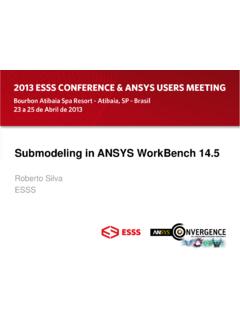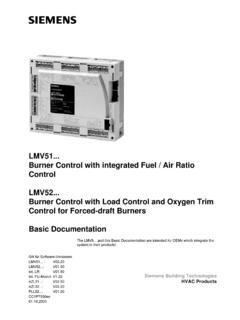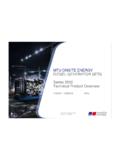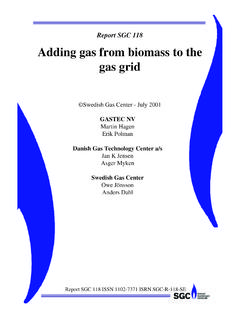Transcription of Best Practice Guidelines for Combustion Modeling
1 Best Practice Guidelines for Combustion ModelingCarlos Eduardo Fontes, ESSSR aphaelDavid A. Bacchi, ESSSPRESENTATION TOPICS Introduction; CombustionPhenomenology; CombustionModeling; ReactionMechanism; Radiation; Case Studies;Introduction Combustion has many important applications in industry; The correct phenomenon representation is important to predict equipment efficiency and non-desired behavior; There are several models in both FLUENT and CFX for different Combustion regimes; The challenge in Combustion Modeling is to describe reaction and fluid flow, which evolution happens in different timescales; Combustion Phenomenology Chemistry stoichiometry chemical kinetics Heat transfer conduction, convection, radiation buoyancy Mass transfer Turbulence turbulence-chemistry interaction Compressibility Particle transportCombustion Phenomenology The mixing between oxidant and fuel in the domain controls the decision of which model can be applied; Combustion Phenomenology Combustion depends directly on Mixing and Chemistry.
2 The relative speed of chemical reaction to mixing is crucial; Fast Reactions: reaction progress is limited by turbulent mixing; Slow Reactions: reaction progress is limited by chemical kinetics; The Damk hlerNumber (Da) represents the ratio of the characteristic turbulent mixing time to the characteristic chemical reaction timeDa= Mixing Time / Chemical Time For Da>> 1, Chemical reaction rates are fast For Da<< 1, Chemical reaction rates are slowCombustion ModelingCombustion ModelingFast ChemistryDa>>1 Non-premixed CombustionPDF FlameletModelEddy-Dissipation/Finite-Rat e Chemistry ModelEddy-Dissipation ModelPremixed CombustionBVM: Burning Velocity ModelEddy-Dissipation/Finite-Rate Chemistry ModelEddy-Dissipation ModelPartially Premixed CombustionBVM: Zimontsub-model Eddy-Dissipation/Finite-Rate Chemistry ModelEddy-Dissipation ModelSlow ChemistryDa<<1 Detailed KineticEddy-Dissipation-Concept Model(FLUENT)Finite-Rate Chemistry ModelNon-Detailed KineticFinite-Rate Chemistry ModelEddy-Dissipation/Finite-Rate chemistryRELEVANCEC ombustion Modeling : Reaction Rate-Based Models Finite Rate Chemistry Model: the effect of turbulent fluctuations are ignored, and reaction rates are determined by Arrhenius kinetic expressions.
3 Eddy-dissipation model: reaction rates are assumed to be controlled by the turbulence Expensive Arrhenius chemical kinetic calculations can be avoided. The model is computationally cheap For realistic results, only one or two step heat-release mechanisms should be used. Eddy-dissipation-concept model: detailed Arrhenius chemical kinetics can be incorporated in turbulent flames Note that detailed chemical kinetic calculations are computationally expensive. FLUENT Eddy-dissipation/Finite-Rate chemistry model: reaction rate is evaluated by both models and the smallest is chosenCombustion Modeling : PDF Flamelet The Combustion is assumed to occur in thin sheets called flame-lets. The turbulent flame is treated as an ensemble of laminar flame-lets; Species transport equations not solved; Only applicable to a two-feed system (Fuel and Oxidizer); Only two scalar quantities (Mixture Fraction and Mixture Fraction Variance) solved along with the momentum and energy equations; The Combustion species extracted from a pre-calculated library as a function of mixture fraction and strain rate; Can model a large number of intermediate species and radicals involved in the Combustion process (cin ticascomplexas).
4 Combustion Modeling : Burning Velocity Model Inpremixedandpartiallypremixedflames,the flame-letshaveadiscontinuitybetweenthebu rntandtheun-burntregions; AFlameFrontTrackingapproachisneeded; Ascalar(ReactionProgress)subdividesthefl owfieldintwodifferentareas,theburntandth eun-burntmixture; Thereactionprogressistheprobabilityofthe reactedstateofthefluidalongthetime; Burntregionsaretreatedsimilartoadiffusio nflamewhereasun-burntregionisrepresented bythecoldmixture; Theeffectofturbulentfluctuationsonthecom bustionprocessistakenintoaccountstatisti cally;Reaction Mechanism Kinetic plays an important role in flame discretizationand emission evaluation; Both ANSYS CFX and ANSYS Fluent presents single-step and two-step reactions; There are also special reaction mechanism for NOx-based species; ANSYS Fluent can import detailed kinetic mechanisms from Reaction Design s Chemkin;Radiation Radiation Modeling is important to represent temperature and heat flux fields accurately in Combustion simulation; The main heat transfer mechanism in equipments like furnaces in near walls is radiation; There are many radiations models in ANSYS CFX and ANSYS Fluent; Some models can predict the absortion and reemission of radiation intensity performed by the burned gases like CO2 and H2O;Case Studies IFRF Swirling Pulverized Coal Flame IFRF industrial scale furnace; Eddy Dissipation model (fuel: pulverized coal); Standard k turbulence model, standard wall functions; P1 with gas-phase absortion coefficient dependence; Thermal and Fuel NOx mechanism.
5 Unstructured hexahedral mesh 70k cells before adaption; 260k cells after region adaption near inlet;Case StudiesCase StudiesCase Studies GE LM-1600 Gas Turbine Combustor Non-premixed, natural gas; MW, 19:1 pressure ratio; Multi-block hexahedral mesh (286 K); Standard k turbulence model; Laminar Flameletmodel: 22 species, 104 reactions reduced GRI-MECH mechanism; Differential diffusion (Le effects) included;Case StudiesCase StudiesCase Studies







